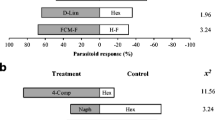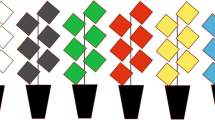Abstract
Female parasitoids are guided by multisensory information, including chemical and physical cues during host location. In the present study, we investigated the behavioural responses of naïve Fopius arisanus (Sonan) females to visual targets baited with guava odour. In non-choice wind tunnel tests, the attraction and landing responses of parasitoids to spheres painted with different colours, and targets of different shapes and sizes were evaluated. Females were more frequently attracted and landed more often on dark yellow targets than on targets with other colours. There was no correlation between the brightness of each colour and the attraction or landing responses. In contrast, both responses were correlated with relative reflectance (hue) of the coloured targets. A positive correlation was observed between attraction and hue, and a negative correlation between landing and hue. F. arisanus was attracted to and landed more often on spheres than on other shape models. The attraction response of this parasitoid was affected by the size of the targets, with spheres of 10 and 12 cm diameter being more attractive than spheres of 8, 6 and 4 cm diameter. The fact that F. arisanus females were able to discriminate among visual targets that differ in colour, shape and size stresses the importance of vision during host location by this species.





Similar content being viewed by others
References
Altuzar A, Montoya P, Rojas JC (2004) Response of Fopius arisanus (Hymenoptera: Braconidae) to fruit volatiles in a wind tunnel. Florida Entomol 87:616–618
Battaglia D, Poppy G, Powell W, Romano A, Tranfaglia A, Pennacchio F (2000) Physical and chemical cues influencing the oviposition behavior of Aphidius ervi. Entomol Exp Appl 94:219–227
Bautista RC, Mochizuki N, Spencer JP, Harris EJ, Ichimura DM (1999) Mass-rearing of the tephritid fruit fly parasitoid Fopius arisanus (Hymenoptera: Braconidae). Biol Control 15:137–144
Bernays EA, Chapman RF (1994) Host-plant selection by phytophagous insects. Chapman & Hall NY
Chittka L, Menzel R (1992) The evolutionary adaptation of flower colours and the insect pollinators colour vision. J Comp Physiol A 171:171–181
Chittka L, Shmida A, Troje N, Menzel R (1994) Ultraviolet as a component of flower reflections, and the colour perception of Hymenoptera. Vision Res 34:1489–1508
Cornelius ML, Duan JJ, Messing RH (1999) Visual stimuli and the response of female oriental fruit fly (Diptera: Tephritidae) to fruit-mimicking traps. J Econ Entomol 92:121–129
Cytrynowicz M, Morgante JS, de Souza HML (1982) Visual response of South American fruit flies, Anastrepha fraterculus, and Mediterranean fruit flies, Ceratitis capitata, to colored rectangles and spheres. Environ Entomol 11:1202–1210
Domínguez J, Artiaga-López T, Solís E, Hernández E (2010) Métodos de colonización y cría masiva. In: Montoya P, Toledo J, Hernández E (eds) Moscas de la fruta: Fundamentos y procedimientos para su manejo, México, pp 259–276
Drew RAI, Prokopy RJ, Romig MC (2003) Attraction of fruit flies of the genus Bactrocera to colored mimics of host fruit. Entomol Exp Appl 107:39–45
Endler JA (1993) The color of light in forests and its implications. Ecol Monogr 63:1–27
Fatouros NE, Dicke M, Mumm R, Meiners T, Hilker M (2008) Foraging behavior of egg parasitoids exploiting chemical information. Behav Ecol 19:677–685
Harris MO, Foster SP (1995) Behavior and integration. In: Cardé RT, Bell W (eds) Chemical ecology of insects, 2nd edn. Chapman & Hall, NY, pp 3–46
Harris EJ, Bautista RC, Spencer JP (2000) Utilisation of the egg-larval parasitoid, Fopius (Biosteres) arisanus, for augmentative biological control of tephritid fruit flies. In: Tan KH (ed) Area-wide control of fruit flies and other insect pests. Penerbit Universiti Sains Malaysia, Penang, pp 725–732
Hebets EA, Papaj DR (2005) Complex signal function: developing a framework of testable hypotheses. Behav Ecol Sociobiol 57:197–214
Henneman ML (1998) Maximization of host encounters by parasitoids foraging in the field: females can use a simple rule. Oecologia 116:467–474
Henneman ML, Dyreson EG, Takabayashi J, Raguso RA (2002) Response to walnut olfactory and visual cues by the parasitic wasp Diachasmimorpha juglandis. J Chem Ecol 28:2221–2244
Ichiki RT, Kainoh Y, Yamawaki Y, Nakamura S (2011) The parasitoid fly Exorista japonica uses visual and olfactory cues to locate herbivore-infested plants. Entomol Exp Appl 138:175–183
Jang EB, Messing RH, Klungness LM, Carvalho LA (2000) Flight tunnel response of Diachasmimorpha longicaudata (Ashmead) (Hymenoptera: Braconidae) to olfactory and visual stimuli. J Insect Behav 13:525–538
Jönsson M, Lindkvist A, Anderson P (2005) Behavioural responses in three ichneumonid pollen beetle parasitoids to volatiles emitted from different phenological stages of oilseed rape. Entomol Exp Appl 115:363–369
Katsoyannos BI (1987) Effect of color properties of spheres on their attractiveness for Ceratitis capitata (Wiedemann) flies in the field. J Appl Entomol 104:79–85
Katsoyannos BI (1989) Response to shape, size and color. In: Robinson AS, Hooper G (eds) Fruit flies: their biology, natural enemies and control, vol 3A. Elsevier, Amsterdam, pp 307–324
Katsoyannos BI, Kouloussis NA (2001) Captures of the olive fruit fly Bactrocera oleae on spheres of different colours. Entomol Exp Appl 100:165–172
Kelber A, Vorobyev M, Osorio D (2003) Animal colour vision-behavioural tests and physiological concepts. Biol Rev 78:81–118
Liquido NJ (1991) Effect of ripeness and location of papaya fruits on the parasitization rates of oriental fruit fly and melon fly (Diptera: Tephritidae) by Braconid (Hymenoptera) parasitoids. Environ Entomol 20:1732–1736
Lobdell CE, Yong TH, Hoffmann MP (2005) Host color preferences and short range searching behavior of the egg parasitoid Trichogramma ostriniae. Entomol Exp Appl 116:127–134
López-Guillén G, Valle-Mora J, Llanderal-Cazares C, Rojas J (2009) Response of Anastrepha obliqua (Diptera: Tephritidae) to visual and chemical cues under seminatural conditions. J Econ Entomol 102:954–959
Messing RH, Jang EB (1992) Response of the fruit fly parasitoid Diachasmimorpha longicaudata (Hymenoptera: Braconidae) to host fruit stimuli. Environ Entomol 21:1189–1195
Montoya P, Suárez A, López F, Cancino J (2009) Fopius arisanus oviposition in four Anastrepha fruit fly species of economic importance in Mexico. BioControl 54:437–444
Peitsch D, Fietz A, Hertel H, de Souza J, Ventura DF, Menzel R (1992) The spectral input systems of hymenopteran insects and their receptor-based colour vision. J Comp Physiol A 170:23–40
Piñero JC, Jácome I, Vargas R, Prokopy RJ (2006) Response of female melon fly Bactrocera cucurbitae, to host-associated visual and olfactory stimuli. Entomol Exp Appl 121:261–269
Prokopy RJ, Owens ED (1983) Visual detection of plants by herbivorous insects. Annu Rev Entomol 28:337–364
Quimio GM, Walter GH (2001) Host preference and host suitability in an egg-pupal fruit fly parasitoid Fopius arisanus (Sonan) (Hym., Braconidae). J Appl Entomol 125:135–140
Rousse P, Harris EJ, Quilici S (2005) Fopius arisanus, an egg-pupal parasitoid of Tephritidae. Overv Biocontr News Info 26:59–69
Rousse P, Gourdon F, Quilici S (2006) Host specificity of the egg pupal parasitoid Fopius arisanus (Hymenoptera: Braconidae) in La Reunion. Biol Control 37:284–290
Rousse P, Chiroleu F, Domerg C, Quilici S (2007a) Naïve Fopius arisanus females respond mainly to achromatic cues. Biol Control 43:41–48
Rousse P, Chiroleu F, Veslot J, Quilici S (2007b) The host and microhabitat olfactory location by Fopius arisanus suggests a broad potential host range. Physiol Entomol 32:313–321
Segura DF, Viscarret MM, Carabajal-Paladino LZ, Ovruski SM, Cladera JL (2007) Role of visual information and learning in habitat selection by a generalist parasitoid foraging for concealed hosts. Anim Behav 74:131–142
Vargas RI, Stark JD, Prokopy RJ, Green TA (1991) Response of oriental fruit fly (Diptera: Tephritidae) and associated parasitoids (Hymenoptera: Braconidae) to different color spheres. J Econ Entomol 84:1503–1507
Vinson SB (1976) Host selection by insect parasitoids. Annu Rev Entomol 21:109–133
Volkl W (2000) Foraging behavior and sequential multisensory orientation in the aphid parasitoid Pauesia picta (Hym., Aphidiidae) at different spatial scales. J Appl Entomol 124:307–314
Wäckers FL, Lewis WJ (1999) A comparison of color, shape, and pattern-learning by the hymenopteran parasitoid Microplitis croceipes. J Comp Physiol A 184:387–393
Wang XG, Messing RH (2003) Foraging behavior and patch time allocation by Fopius arisanus (Hymenoptera: Braconidae), an egg-larval parasitoid of tephritid fruit flies. J Insect Behav 16:593–612
Acknowledgments
We are grateful for the technical assistance of Florida López (PROGRAMA MOSCAFRUT) and Armando Virgen (ECOSUR). Rosalba Morales provided logistic support. Many thanks go to Javier Valle Mora for statistical advice and Francisco Infante and Trevor Williams for a critical review of a previous version of the manuscript. J. Pérez gives special thanks to El Consejo Nacional de Ciencia y Tecnología (CONACYT) of Mexico for the doctoral scholarship.
Author information
Authors and Affiliations
Corresponding author
Additional information
Handling Editor: Torsten Meiners
Rights and permissions
About this article
Cite this article
Pérez, J., Rojas, J.C., Montoya, P. et al. Size, shape and hue modulate attraction and landing responses of the braconid parasitoid Fopius arisanus to fruit odour-baited visual targets. BioControl 57, 405–414 (2012). https://doi.org/10.1007/s10526-011-9416-0
Received:
Accepted:
Published:
Issue Date:
DOI: https://doi.org/10.1007/s10526-011-9416-0




